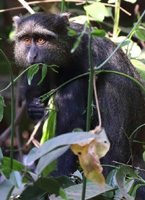|
 The Blue Monkey is a species of Old World monkey native to Central
and East Africa, ranging from the upper Congo River basin east to
the East African Rift and south to northern Angola and Zambia. They
are found in evergreen forests and montane bamboo forests, and lives
largely in the forest canopy, which provides both food and shelter.
They are very dependent on humid, shady areas with plenty of water
and eat mainly fruit and leaves, but will take some slower-moving
invertebrates. Despite their name, the blue monkey is not noticeably
blue; they are mainly olive or grey apart from the face, the blackish
cap, feet, and front legs, and the mantle, which is brown, olive,
or grey depending on the subspecies. They range from 50 to 65 cm
in length, (not including the tail, which is almost as long as the
rest of the animal), with females weighing a little over 4 kg and
males up to 8 kg. The blue monkeys live in female-philopatric social
systems where females stay in their natal groups, while males disperse
once they reach adulthood. Group sizes range from 10 to 40, containing
only a single adult male. They are often found in groups with other
species of monkeys such as the red-tailed monkey and various red
colobus monkeys since they sometimes join other monkeys for extra
protection. Their groups usually consist of one male with several
females and infants, and this gives rise to matrilinear societies.
In these female-bonded societies, only 5-15% of their activity budget
is occupied by social interactions and the most common social interactions
within a group are grooming and playing. Relationships between group
members vary: infants interact most frequently with their peers
and adult or juvenile females and are rarely seen near adult males.
Alloparenting is common among blue monkeys. The most common infant
handlers are juvenile females, and usually one infant is carried
by a number of alloparents, possibly to allow the infant to learn
to socialise at an early stage in life. Their mating system is polygynous,
with a corresponding sexual dimorphism in size, as the males are
the substantially larger sex. The males mate with more than one
female, but the females only mate with one male. The female attracts
males to copulate with her through body language. Females normally
give birth every two years, during the onset of the warm, rainy
season; gestation is around five months, and the infants are born
with fur and with their eyes open. Like almost all guenons, the
Blue Monkey suffers from a loss of its natural habitat. As well,
where pine plantations replace natural forest, they may be treated
as a threat by foresters, since they sometimes strip bark from exotic
trees in a search for food or moisture. They are also hunted for
bushmeat.
The Blue Monkey is a species of Old World monkey native to Central
and East Africa, ranging from the upper Congo River basin east to
the East African Rift and south to northern Angola and Zambia. They
are found in evergreen forests and montane bamboo forests, and lives
largely in the forest canopy, which provides both food and shelter.
They are very dependent on humid, shady areas with plenty of water
and eat mainly fruit and leaves, but will take some slower-moving
invertebrates. Despite their name, the blue monkey is not noticeably
blue; they are mainly olive or grey apart from the face, the blackish
cap, feet, and front legs, and the mantle, which is brown, olive,
or grey depending on the subspecies. They range from 50 to 65 cm
in length, (not including the tail, which is almost as long as the
rest of the animal), with females weighing a little over 4 kg and
males up to 8 kg. The blue monkeys live in female-philopatric social
systems where females stay in their natal groups, while males disperse
once they reach adulthood. Group sizes range from 10 to 40, containing
only a single adult male. They are often found in groups with other
species of monkeys such as the red-tailed monkey and various red
colobus monkeys since they sometimes join other monkeys for extra
protection. Their groups usually consist of one male with several
females and infants, and this gives rise to matrilinear societies.
In these female-bonded societies, only 5-15% of their activity budget
is occupied by social interactions and the most common social interactions
within a group are grooming and playing. Relationships between group
members vary: infants interact most frequently with their peers
and adult or juvenile females and are rarely seen near adult males.
Alloparenting is common among blue monkeys. The most common infant
handlers are juvenile females, and usually one infant is carried
by a number of alloparents, possibly to allow the infant to learn
to socialise at an early stage in life. Their mating system is polygynous,
with a corresponding sexual dimorphism in size, as the males are
the substantially larger sex. The males mate with more than one
female, but the females only mate with one male. The female attracts
males to copulate with her through body language. Females normally
give birth every two years, during the onset of the warm, rainy
season; gestation is around five months, and the infants are born
with fur and with their eyes open. Like almost all guenons, the
Blue Monkey suffers from a loss of its natural habitat. As well,
where pine plantations replace natural forest, they may be treated
as a threat by foresters, since they sometimes strip bark from exotic
trees in a search for food or moisture. They are also hunted for
bushmeat.
|
 The
Blue Monkey - Issue
Thirty-Four
The
Blue Monkey - Issue
Thirty-Four